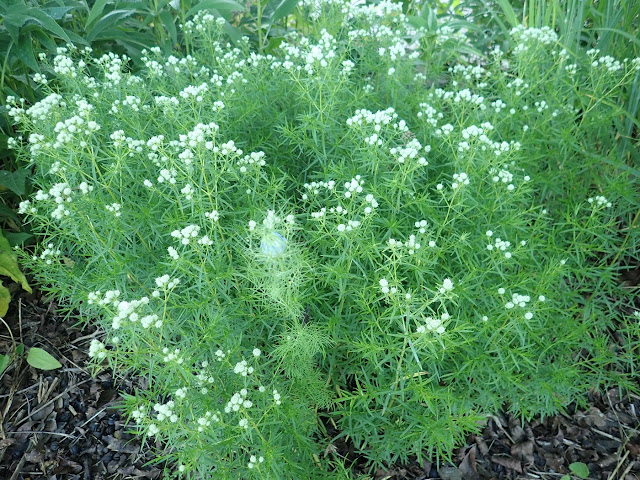It's been a HOT start to summer in Tennessee.
In fact, since mid-May we've been running 5 to 15 degrees above normal every day -- that means lots of days in the high 80s and low 90s with high humidity. At the same time, we've had less rain than usual, so plants are being asked to cope with the double whammy of higher than normal temperatures and less water than usual.
Nonetheless, as you can see from the following photos, most plants are growing and blooming like gangbusters.
(And lest you think I'm stacking the deck, I've watered these plants a grand total of once this year so far.)
What's the secret? It's not amending the soil (although I'm sure the plants would do even better if I had the time, patience, energy and/or money to do that). I think it comes down to picking the right plants for the right place - real tough guys and gals, giving them a good start with proper planting techniques, offering them a little help to get settled and then standing back to let them flourish.
Without further ado, I give you...
 |
| The Carefree Beauty rose, lightly reblooming. |
 |
| Anise hyssop, Agastache foeniulum, beloved of bees and goldfinches |
 |
| Agastache foeniculum reseeds just the right amount in my garden. It produces plenty of volunteers, but I'd never call it weedy. |
 |
| I'm digging this fortuitous combo of yellow mustard green (Brassica juncea) flowers with the purple flower spikes of Agastache foeniculum. |
 |
| Common milkweed (Asclepias syriaca) flowers have a lovely, sweet fragrance. This is a volunteer plant that sprouted near my mailbox. It hasn't spread much over the past few years, but it sure is tenacious. I did try digging it up once it came right back. If stems or leaves are broken, the plant exudes its trademark sticky, latex sap. Some years, the plant attracts monarch butterflies and provides food for their caterpillars, but I have not seen any monarchs yet this year. The flower umbels are highly attractive to pollinators. |
 |
| Here's another milkweed that blooms and flowers earlier than its brethren - Asclepias viridis, spider milkweed. For a low-growing plant it produces relatively enormous seedpods that attract startlingly red milkweed bugs. |
 |
| Southern bush honeysuckle (Diervilla sessilifolia) flowers. It's my first year with this plant and I'm testing it in a difficult spot on a steep hill. It seems to be doing great so far! |
 |
| It's also my first year with the native annual Monarda citriodora, a.k.a. lemon bee balm. |
 |
| Monarda citriodora seems to be a big hit with the pollinators. And so far it seems much tougher - more drought tolerant and mildew resistant - than its perennial cousins. Unlike some other monardas (e.g., Monarda didyma) it does not spread by underground stems, but I have heard that lemon bee balm can be a prolific reseeder. The seeds certainly do germinate easily -- I simply scattered them in the garden beds over the winter and let nature handle the scarification / stratification process. |
 |
| This is a slowly expanding clump of thin-leaved mountain mint (Pycnanthemum tenuifolium). But wait... Do you see something different in its midst? Or should I say mist? |
 |
| Yep, it's a love-in-the-mist (Nigella damascena) seedling. Years after I started trying to remove this rampant self-seeder from my garden, it keeps popping up here and there. |
 |
| My carrot crop was a flop, but I left a few carrots in the ground and they have produced these pretty white umbels of flowers that attract small pollinators. |
 |
| Masses of partridge pea (Chamaecrista fasciculata) seedlings form an effective groundcover. |
 |
| Here is the first partridge pea flower that I've seen this year. Soon there will be countless yellow blooms and busy buzzing bees. |
 |
| The oakleaf hydrangea florets are fading from white to pink. |
 |
| This is an intermediate stage. Eventually they will change from pink to tan. But for now, they are adorned with a pretty rosy blush. |




















